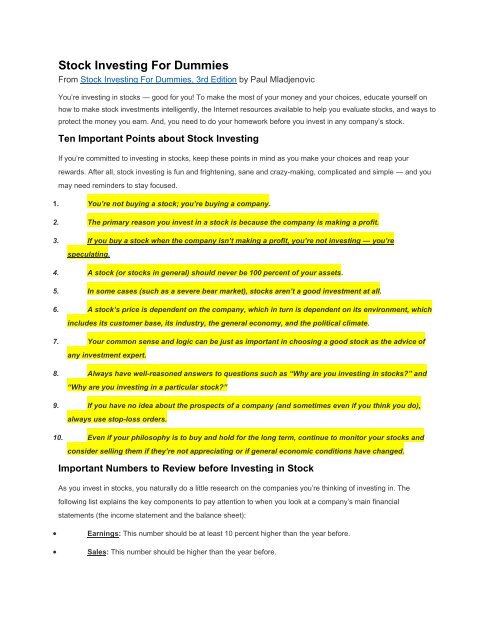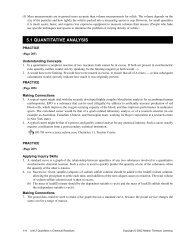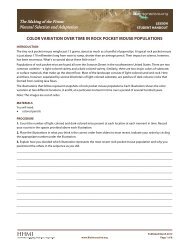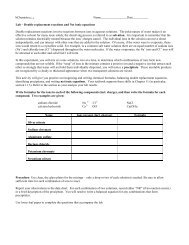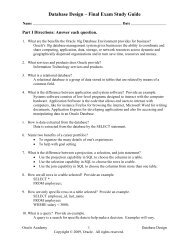Stock Investing For Dummies - Quia
Stock Investing For Dummies - Quia
Stock Investing For Dummies - Quia
You also want an ePaper? Increase the reach of your titles
YUMPU automatically turns print PDFs into web optimized ePapers that Google loves.
<strong>Stock</strong> <strong>Investing</strong> <strong>For</strong> <strong>Dummies</strong><br />
From <strong>Stock</strong> <strong>Investing</strong> <strong>For</strong> <strong>Dummies</strong>, 3rd Edition by Paul Mladjenovic<br />
You’re investing in stocks — good for you! To make the most of your money and your choices, educate yourself on<br />
how to make stock investments intelligently, the Internet resources available to help you evaluate stocks, and ways to<br />
protect the money you earn. And, you need to do your homework before you invest in any company’s stock.<br />
Ten Important Points about <strong>Stock</strong> <strong>Investing</strong><br />
If you’re committed to investing in stocks, keep these points in mind as you make your choices and reap your<br />
rewards. After all, stock investing is fun and frightening, sane and crazy-making, complicated and simple — and you<br />
may need reminders to stay focused.<br />
1. You’re not buying a stock; you’re buying a company.<br />
2. The primary reason you invest in a stock is because the company is making a profit.<br />
3. If you buy a stock when the company isn’t making a profit, you’re not investing — you’re<br />
speculating.<br />
4. A stock (or stocks in general) should never be 100 percent of your assets.<br />
5. In some cases (such as a severe bear market), stocks aren’t a good investment at all.<br />
6. A stock’s price is dependent on the company, which in turn is dependent on its environment, which<br />
includes its customer base, its industry, the general economy, and the political climate.<br />
7. Your common sense and logic can be just as important in choosing a good stock as the advice of<br />
any investment expert.<br />
8. Always have well-reasoned answers to questions such as “Why are you investing in stocks?” and<br />
“Why are you investing in a particular stock?”<br />
9. If you have no idea about the prospects of a company (and sometimes even if you think you do),<br />
always use stop-loss orders.<br />
10. Even if your philosophy is to buy and hold for the long term, continue to monitor your stocks and<br />
consider selling them if they’re not appreciating or if general economic conditions have changed.<br />
Important Numbers to Review before <strong>Investing</strong> in <strong>Stock</strong><br />
As you invest in stocks, you naturally do a little research on the companies you’re thinking of investing in. The<br />
following list explains the key components to pay attention to when you look at a company’s main financial<br />
statements (the income statement and the balance sheet):<br />
<br />
<br />
Earnings: This number should be at least 10 percent higher than the year before.<br />
Sales: This number should be higher than the year before.
Debt: This number should be lower than or about the same as the year before. It should also be lower than<br />
the company’s assets.<br />
Equity: This number should be higher than the year before.<br />
Volume*: This can be good or bad, depending on the stock.<br />
* My comment only.<br />
Financial Measures to Consider before <strong>Investing</strong> in <strong>Stock</strong><br />
You’re thinking of buying stock in a company, but before you invest your hard-earned money in hopes of a profitable<br />
return, check out some financial ratios that can help indicate whether the company is on sound financial footing. Here<br />
are key measures to consider:<br />
<br />
<br />
<br />
<br />
<br />
Price-to-earnings ratio (P/E): <strong>For</strong> large cap stocks, the ratio should be under 20. <strong>For</strong> all stocks (including<br />
growth, small cap, and speculative issues), it shouldn’t exceed 40.<br />
Price to sales ratio (PSR): The PSR should be as close to 1 as possible.<br />
Return on equity (ROE): ROE should be going up by at least 10 percent per year.<br />
Earnings growth: Earnings should be at least 10 percent higher than the year before. This rate should be<br />
maintained over several years.<br />
Debt to asset ratio: Debt should be half of assets or less.<br />
What to Read before <strong>Investing</strong> in <strong>Stock</strong><br />
Before you invest in a company by buying stock in it, you need to do a little light — or not-so-light — reading.<br />
<strong>Investing</strong> in stock without checking out the company beforehand is a recipe for disaster. So, before you plunk down<br />
your money, be sure to do the following reading:<br />
<br />
<br />
<br />
<br />
<br />
<br />
The company’s annual report<br />
The 10K and 10Q reports that the company files with the SEC<br />
Standard & Poor’s <strong>Stock</strong> Reports<br />
Value Line Investment Survey<br />
The Wall Street Journal and/or Investor’s Business Daily<br />
Reputable stock investing Web sites<br />
Internet Resources for <strong>Stock</strong> <strong>Investing</strong><br />
With the tools available on the Internet, you have no excuse for not researching any and every potential stock<br />
investment. The following list of resources links you to some of the best financial Web sites around. Look at what they<br />
have to say about a company or an investment before you take the plunge.<br />
<br />
Barron’s
Bloomberg<br />
Financial Sense<br />
Le Metropole Café<br />
MarketWatch<br />
The Mises Institute<br />
Securities and Exchange Commission<br />
Yahoo! Finance<br />
How to Protect Your <strong>Stock</strong> <strong>Investing</strong> Profits<br />
Besides being smart about your stock investments, you should protect the money your investments have earned.<br />
Protecting stock market profits means being on the defense. These tips will help:<br />
<br />
<br />
<br />
<br />
<br />
<br />
<br />
<br />
Always try to have some extra cash on the side, no matter how tempted you are to be 100 percent fully<br />
invested; you never know when buying opportunities may show up.<br />
Spread your money across several stocks.<br />
Buy more of a down (yet solid) stock.<br />
Even if you make what you think is the greatest choice in stock market history and still see the price decline,<br />
just wait; common sense takes over regarding a stock price over a protracted period. Long term, good choices go<br />
up and bad choices go down. (<strong>Investing</strong> in <strong>Stock</strong>s by Term explains the differences between long- and short-term<br />
stock investing.)<br />
Use stop-loss orders, trailing stop orders, and limit orders.<br />
Set up broker triggers.<br />
Consider put options and covered call options.<br />
Sell, if you absolutely must.<br />
See also:<br />
How to Read a <strong>Stock</strong> Table<br />
How to Invest Based on <strong>Stock</strong> Market Indexes<br />
How to Sharpen Your <strong>Stock</strong> Investment Skills<br />
<strong>Stock</strong> <strong>Investing</strong> for Your Personal Style


